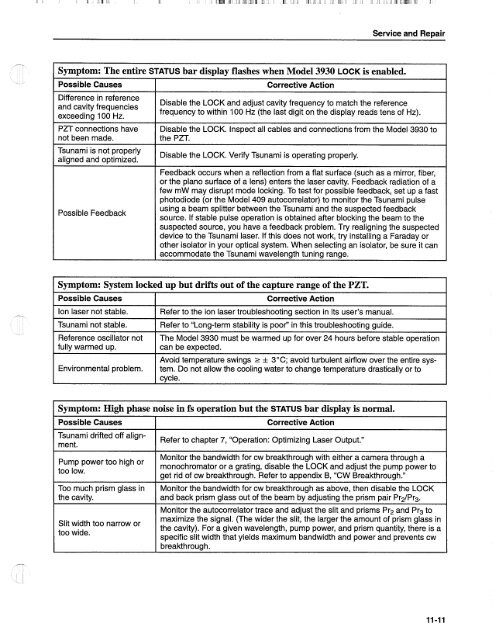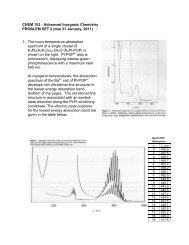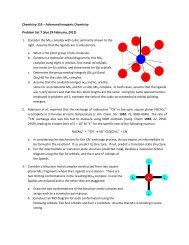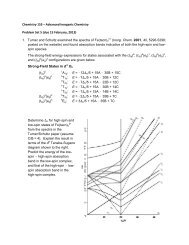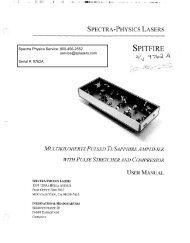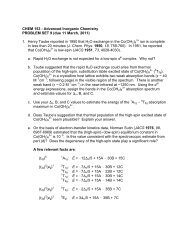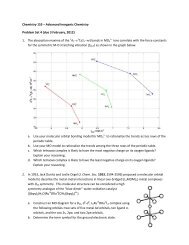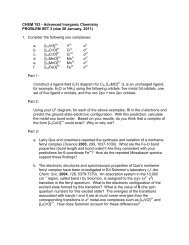Tsunami - Beckman Institute Laser Resource Center
Tsunami - Beckman Institute Laser Resource Center
Tsunami - Beckman Institute Laser Resource Center
You also want an ePaper? Increase the reach of your titles
YUMPU automatically turns print PDFs into web optimized ePapers that Google loves.
I I I il l I 11 I I I I l l<br />
I<br />
, I Ill , I1 I Ill. .ll i I I. 111 I 11 1 1<br />
Service and Repair<br />
Symptom: The entire STATUS bar display flashes when Model 3930 LOCK is enabled.<br />
Possible Causes<br />
Difference in reference<br />
and cavity frequencies<br />
exceeding 100 Hz.<br />
PZT connections have<br />
not been made.<br />
<strong>Tsunami</strong> is not properly<br />
aligned and optimized.<br />
Possible Feedback<br />
Corrective Action<br />
Disable the LOCK and adjust cavity frequency to match the reference<br />
frequency to within 100 Hz (the last digit on the display reads tens of Hz).<br />
Disable the LOCK. Inspect all cables and connections from the Model 3930 to<br />
the PZT.<br />
Disable the LOCK. Verify <strong>Tsunami</strong> is operating properly.<br />
Feedback occurs when a reflection from a flat surface (such as a mirror, fiber,<br />
or the plano surface of a lens) enters the laser cavity. Feedback radiation of a<br />
few mW may disrupt mode locking. To test for possible feedback, set up a fast<br />
photodiode (or the Model 409 autocorrelator) to monitor the <strong>Tsunami</strong> pulse<br />
using a beam splitter between the <strong>Tsunami</strong> and the suspected feedback<br />
source. If stable pulse operation is obtained after blocking the beam to the<br />
suspected source, you have a feedback problem. Try realigning the suspected<br />
device to the <strong>Tsunami</strong> laser. If this does not work, try installing a Faraday or<br />
other isolator in your optical system. When selecting an isolator, be sure it can<br />
accommodate the <strong>Tsunami</strong> wavelength tuning range.<br />
Symptom: System locked up but drifts out of the capture range of the PZT.<br />
Possible Causes<br />
Ion laser not stable.<br />
<strong>Tsunami</strong> not stable.<br />
Reference oscillator not<br />
fully warmed up.<br />
Environmental problem.<br />
Corrective Action<br />
Refer to the ion laser troubleshooting section in its user's manual.<br />
Refer to "Long-term stability is poor" in this troubleshooting guide.<br />
The Model 3930 must be warmed up for over 24 hours before stable operation<br />
can be expected.<br />
Avoid temperature swings r + 3°C; avoid turbulent airflow over the entire system.<br />
Do not allow the cooling water to change temperature drastically or to<br />
cycle.<br />
-<br />
I<br />
Symptom: High phase noise in fs operation but the STATUS bar display is normal.<br />
Possible Causes<br />
<strong>Tsunami</strong> drifted Off alignment.<br />
Pump power too high Or<br />
too low.<br />
Too much prism glass in<br />
the cavity.<br />
'lit width too narrow Or<br />
too wide.<br />
Corrective Action<br />
Refer to chapter 7, 'operation: Optimizing <strong>Laser</strong> Output."<br />
Monitor the bandwidth for cw breakthrough with either a camera through a<br />
monochromator or a grating, disable the LOCK and adjust the pump power to<br />
get rid of cw breakthrough. Refer to appendix B, "CW Breakthrough."<br />
Monitor the bandwidth for cw breakthrough as above, then disable the LOCK<br />
and back prism glass out of the beam by adjusting the prism pair Pr2/Pr3.<br />
Monitor the autocorrelator trace and adjust the slit and prisms Pr2 and Pr3 to<br />
maximize the signal. (The wider the slit, the larger the amount of prism glass in<br />
the cavity). For a given wavelength, pump power, and prism quantity, there is a<br />
specific slit width that yields maximum bandwidth and power and prevents cw<br />
breakthrough.


